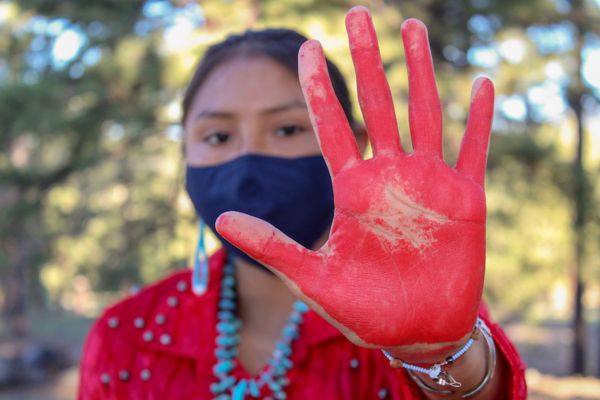
- Details
- By Elyse Wild
On July 26th, the Not Invisible Act Commission (NIAC) wrapped up its final stop on a seven-city nationwide tour gathering testimony from Native Americans affected by the Missing and Murdered Indigenous Persons (MMIP) crisis.
This week’s hearing took place in Billings, Montana, where Tribal officials, Native leaders, law enforcement and government officials convened for a panel discussion and to bear witness to testimony from MMIP survivors and family members. The hearing was also live streamed.
The hearing opened with a prayer and moment of silence, followed by an invitation for those in attendance to speak the name of a missing or murdered loved one. Names were spoken aloud for ten minutes.
Among those testifying was Carrisa Heavyrunner, whose 22-year-old daughter Mika Westwolf (Blackfeet) was killed in a hit-and-run on March 31 on Highway 93 near Arlee, Montana. Despite the Montana Highway Patrol identifying the driver as Sunny K. White, no arrests have been made in Westwolf’s death.
Heavyrunner told Billings news station NonStop Local that the lack of urgency from law enforcement is slowing healing for Native American communities affected by the MMIP crisis.
“You can’t heal if you’re not able to be seen and be heard,” Heavyrunner said. “That’s why I wanted to help these women share their stories about their loved ones that they lost… We gotta keep Mika’s name and other MMIP families and victims out there because everyone tends to forget things so easily nowadays. We’ve gotta keep the momentum going.”
According to data from the Centers for Disease Control and Prevention, Native women living on reservations are murdered at a rate ten times higher than the national average. Lack of jurisdictional clarity, lack of collaboration between law enforcement bodies, and systemic apathy have led to thousands of unsolved cases in Indian Country. While there is no comprehensive data on MMIP, the Bureau of Indian Affairs estimates there are 4,200 unsolved MMIP cases have gone unsolved. The oldest MMIP case profile on the BIA’s public MMIP database dates back to 1969.
Montana is home to twelve Tribal Nations and ranks among the states with the highest number of MMIPs in the nation, according to a report from the Urban Indian Health Institute.
The 37-person Not Invisible Act Commission was launched in 2020 by Secretary of the Interior Deb Haaland (Laguna Pueblo). The commission is tasked with developing recommendations on improving intergovernmental collaboration on violent crimes in Indian Country and providing resources for survivors and victims’ families. Information and testimony gathered at the hearings will be part of the commission’s final report to Secretary Haaland, Attorney General Merrick Garland and Congress in October.
The commission will hold a nationwide virtual hearing on Aug. 1 and 2. Registration for the hearing can be found here.
More Stories Like This
Native News Weekly (August 25, 2024): D.C. BriefsUS Presidents in Their Own Words Concerning American Indians
Indigenous Actor Elaine Miles Reports Detention by Alleged ICE Agents
Happy Thanksgiving from Native News Online
Coming Up on Native Bidaské: Behind the Animation: Joey Clift Talks “Pow” and Native Storytelling
Help us tell the stories that could save Native languages and food traditions
At a critical moment for Indian Country, Native News Online is embarking on our most ambitious reporting project yet: "Cultivating Culture," a three-year investigation into two forces shaping Native community survival—food sovereignty and language revitalization.
The devastating impact of COVID-19 accelerated the loss of Native elders and with them, irreplaceable cultural knowledge. Yet across tribal communities, innovative leaders are fighting back, reclaiming traditional food systems and breathing new life into Native languages. These aren't just cultural preservation efforts—they're powerful pathways to community health, healing, and resilience.
Our dedicated reporting team will spend three years documenting these stories through on-the-ground reporting in 18 tribal communities, producing over 200 in-depth stories, 18 podcast episodes, and multimedia content that amplifies Indigenous voices. We'll show policymakers, funders, and allies how cultural restoration directly impacts physical and mental wellness while celebrating successful models of sovereignty and self-determination.
This isn't corporate media parachuting into Indian Country for a quick story. This is sustained, relationship-based journalism by Native reporters who understand these communities. It's "Warrior Journalism"—fearless reporting that serves the 5.5 million readers who depend on us for news that mainstream media often ignores.
We need your help right now. While we've secured partial funding, we're still $450,000 short of our three-year budget. Our immediate goal is $25,000 this month to keep this critical work moving forward—funding reporter salaries, travel to remote communities, photography, and the deep reporting these stories deserve.
Every dollar directly supports Indigenous journalists telling Indigenous stories. Whether it's $5 or $50, your contribution ensures these vital narratives of resilience, innovation, and hope don't disappear into silence.
 The stakes couldn't be higher. Native languages are being lost at an alarming rate. Food insecurity plagues many tribal communities. But solutions are emerging, and these stories need to be told.
The stakes couldn't be higher. Native languages are being lost at an alarming rate. Food insecurity plagues many tribal communities. But solutions are emerging, and these stories need to be told.
Support independent Native journalism. Fund the stories that matter.
Levi Rickert (Potawatomi), Editor & Publisher

